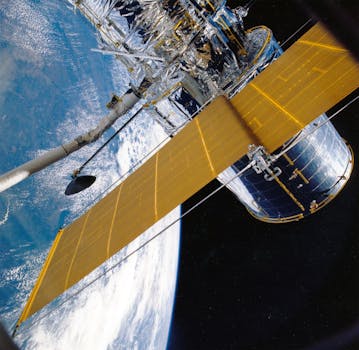
Satellite Telecommunications is the focus keyword of this article, and it represents the future of global communication. The future of satellite telecommunications is now, with cutting-edge innovations transforming the way we communicate and access information. Satellite telecommunications have come a long way since the launch of the first commercial communications satellite, Intelsat 1, in 1965. Today, satellite telecommunications play a vital role in providing global connectivity, enabling communication between remote and underserved communities, and supporting critical infrastructure such as navigation, weather forecasting, and disaster response.
One of the most significant innovations in satellite telecommunications is the development of high-throughput satellites (HTS). HTS offer faster data speeds, higher capacity, and greater flexibility than traditional satellites, making them ideal for applications such as broadband internet, mobile networks, and video transmission. Companies such as ViaSat, Hughes Network Systems, and Intelsat are leading the charge in HTS technology, launching new satellites and services that are revolutionizing the industry.
Another area of innovation in satellite telecommunications is the use of advanced propulsion systems. Traditional satellites rely on chemical propulsion systems, which are heavy, expensive, and limited in their maneuverability. New electric propulsion systems, such as those developed by companies like SpaceX and Blue Origin, offer greater efficiency, flexibility, and cost-effectiveness. These systems enable satellites to change orbit, adjust their position, and extend their lifespan, reducing the need for replacement satellites and minimizing the risk of collisions and debris.
Advancements in Satellite Technology
Advances in satellite technology are also driving innovation in satellite telecommunications. New satellite designs, such as the use of smaller satellites, known as smallsats, and the development of satellite constellations, are enabling more efficient and cost-effective satellite deployments. Smallsats, which are typically smaller than 500 kilograms, offer greater flexibility and maneuverability than traditional satellites, making them ideal for applications such as Earth observation, communications, and navigation.
Satellite constellations, which involve launching multiple satellites into a coordinated orbit, are also becoming increasingly popular. Companies such as OneWeb, Amazon’s Kuiper Systems, and SpaceX’s Starlink are developing satellite constellations to provide global internet connectivity, enabling unprecedented levels of access to information and communication. These constellations will also support a wide range of applications, including IoT, autonomous vehicles, and smart cities.
The development of new materials and manufacturing techniques is also transforming the satellite industry. Advances in 3D printing, for example, are enabling the creation of complex satellite components, such as antennas and propulsion systems, with greater speed and efficiency. New materials, such as advanced composites and nanomaterials, are also being used to reduce the weight and increase the strength of satellites, enabling them to carry more payload and operate for longer periods.
Impact on Society and the Environment
The impact of satellite telecommunications on society and the environment is significant. Satellite telecommunications are enabling global connectivity, bridging the digital divide, and supporting critical infrastructure. They are also providing vital services, such as navigation, weather forecasting, and disaster response, which are essential for public safety and economic development.
However, the growth of the satellite industry also raises concerns about the environmental impact of satellite deployments. The increasing number of satellites in orbit is contributing to space debris, which poses a risk to operational satellites and the environment. The use of non-renewable energy sources, such as fossil fuels, is also a concern, as it contributes to climate change and air pollution.
To mitigate these risks, the satellite industry is adopting more sustainable practices, such as the use of renewable energy sources, environmentally friendly materials, and responsible satellite disposal. Companies are also developing new technologies, such as satellite recycling and debris removal, to minimize the environmental impact of satellite deployments.
Conclusion
In conclusion, the future of satellite telecommunications is now, with cutting-edge innovations transforming the way we communicate and access information. The development of high-throughput satellites, advanced propulsion systems, and new satellite technologies is enabling greater efficiency, flexibility, and cost-effectiveness in satellite deployments. The impact of satellite telecommunications on society and the environment is significant, and the industry must adopt sustainable practices to minimize its environmental footprint.
As the satellite industry continues to evolve, we can expect to see even more innovative technologies and applications emerge. The use of artificial intelligence, machine learning, and the Internet of Things (IoT) will enable greater automation, efficiency, and connectivity in satellite telecommunications. The development of new business models, such as satellite-as-a-service, will also provide greater flexibility and affordability for satellite users.



